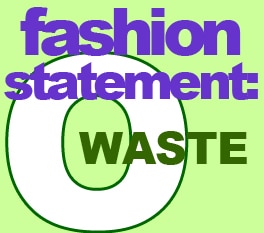 Corporate social responsibility is in style, no doubt about it. Now, it appears that “waste-reduction” is also “in fashion.” Two major fashion retailers have launched fashion-forward waste-reduction sustainability campaigns that could revolutionize the industry. Marks & Spencer, and H&M are each making sustainability sexy via programs that encourage and facilitate reducing, reusing, recycling and upcycling. These brands are meeting their consumers where they are – at the mall – with programs that engage them around a topic that is of significant importance to them, environmental impact. Not unlike the perfect little black dress, thoughtfully designed CSR programs can become priceless.
Corporate social responsibility is in style, no doubt about it. Now, it appears that “waste-reduction” is also “in fashion.” Two major fashion retailers have launched fashion-forward waste-reduction sustainability campaigns that could revolutionize the industry. Marks & Spencer, and H&M are each making sustainability sexy via programs that encourage and facilitate reducing, reusing, recycling and upcycling. These brands are meeting their consumers where they are – at the mall – with programs that engage them around a topic that is of significant importance to them, environmental impact. Not unlike the perfect little black dress, thoughtfully designed CSR programs can become priceless.
There are a myriad of studies emphasizing the importance that millennials and other consumers place on social impact. These two brands look to be making a grab for market share in the fashion space when it comes to sustainability. To hold onto the lead, they’ll need to continue meaningful consumer engagement and tell compelling stories showcasing specific impact and authentic commitment.
MARKS & SPENCER – SHWOP (SHOP + SWAP = SHWOP)
 British retailer Marks & Spencer created the “Shwop” program to inspire a fashion revolution. The brand has set out to create a new standard for the fashion industry by focusing on the impact that can be made by re-using, recycling and upcycling (but you already knew that since we gave you the heads-up in a recent Cause twINFO post).
British retailer Marks & Spencer created the “Shwop” program to inspire a fashion revolution. The brand has set out to create a new standard for the fashion industry by focusing on the impact that can be made by re-using, recycling and upcycling (but you already knew that since we gave you the heads-up in a recent Cause twINFO post).
Consumers can donate clothing, accessories and shoes at permanent in-store shwop boxes and at pop-up shwops. For doing so, they are entered into a weekly drawing for a £100 gift card. Related prize drawings also take place on Facebook. Consumers’ shwopped items are donated to Marks & Spencer’s nonprofit partner Oxfam who resells, reuses or recycles them to help people around the world overcome poverty. This is a zero-waste program. Since 2008, over 10 million garments have been schwopped, equating to £8 million (or 421,052 fishing rods, for example).


To raise awareness the campaign utilizes social media, celebrities and creative guerrilla marketing tactics like dressing a factory with 10,000 used clothing items to help people visualize the enormous amount of clothing going into UK landfills every 5 minutes. Check it out here.
Shwop is part of Marks & Spencer’s environmental and ethical program “Plan A” which aims to make it the world’s most sustainable major retailer by 2015.
Harvard Business Review’s “Can Advertising Change The World?” blog post by Julia Kirby, includes this perspective from Marks & Spencer CEO, Marc Bolland:
“We’re leading a change in the way we all shop for clothing, forever.” He hopes the movement will catch on to the point where all stores take back one garment for every one they sell. “For us that’s 350 million a year,” he says. “It is a big number, but with our customers’ help, we will do it.”
Well, it looks like it worked Mr. Bolland…
H&M LAUNCHES FIRST EVER GLOBAL GARMENT RECYCLING PROGRAM

This week, H&M (#42 on Forbes Most Powerful Brands) launched its own garment recycling program “Don’t Let Fashion Go To Waste,” claiming honor of “first global garment recycling program.” Consumers can bring up to 2 bags of clothes per day (in any condition) to donate via 1,500 fashion collection boxes worldwide (269 U.S. locations plus 48 global markets) located in H&M retail locations. Clothing donors receive a coupon for 15% off-a-single-item for each bag contributed. H&M will donate 1 cent per pound of clothing collected to “a local charity chosen by H&M.”


H&M has partnered with I:CO, which stands for “I collect.” I:CO provides the infrastructure to ensure that valuable raw materials from the donated textiles enter a closed loop production cycle and remain there. From collection to recycling, consumer goods are recycled and put to a new use, thus actively contributing to climate protection.
Click here to learn more about H&M’s sustainability efforts or view their 7-point commitment showcased here in H&M Conscious Actions 2011 Highlights.
There are certainly other fashion retailers facilitating the donation of clothing to support good causes (Burlington Coat Factory & One Warm Coat, Aeropostale & DoSomething.org, and BonTon & Goodwill Industries come to mind). However, the angle promoted by Marks & Spencer and H&M of sustainability via waste-reduction is a new approach that pivots to make sustainability the “cause” being “marketed” through “strategic partnerships.” Deeper integration of cause marketing strategies within broader CSR programs like these is an emerging trend due to consumer demand for social impact and sustainability information/engagement combined with the coming of age of cause marketing as a viable practice.
Now…if they could just give me a coupon for 3 inches of guaranteed “waist”-reduction when I support these “waste”-reduction programs I’d definitely be a customer for life!
